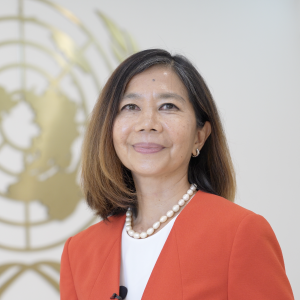Dissemination Workshop on the Study Results of “Accelerating Sustainable Development in Viet Nam: Policy Options”
Opening Remarks by Ms. Pauline Tamesis, UN Resident Coordinator
• Vice Minister Nguyen Thi Bich Ngoc, Ministry of Planning and Investment;
• Dr. Le Viet Anh, Director General, Department of Science, Education, Natural Resources and Environment, Ministry of Planning and Investment;
• Mr. Vatcharin Sirimaneetham, Chief of Macroeconomic Policy and Analysis Section, UNESCAP;
• Honourable Government Delegates, Development Partners, Distinguished Guests,
I highly appreciate your time and engagement in today’s Workshop on Dissemination of the Study Results on “Accelerating Sustainable Development in Viet Nam: Policy Options”. I am eager to learn and exchange with you on how we can together advance SDG progress in Viet Nam where no one is left behind.
I must start with sincerest gratitude to our partner, Ministry of Planning and Investment (MPI), particularly the Department of Science, Education, Natural Resources and Environment (DSENRE). Without MPI’s close collaboration with UN ESCAP and the UN in Viet Nam, we would not be here today to learn the results of the joint macroeconomic modelling exercise.
Distinguished Participants, Colleagues,
Viet Nam has sustained high economic growth, improved living standards and reduced multidimensional poverty, despite setbacks during the COVID-19. With this record of success, Viet Nam has set a higher bar for its development journey: to become a high-income country by 2045 and to realize net-zero emissions by 2050. This vision encompasses Viet Nam’s determination to realize the Sustainable Development Goals (SDGs) by 2030.
At the 79th session of the UN General Assembly and at the Summit of the Future in September, Party General Secretary, H.E. Mr. To Lam welcomed the adoption of the Pact for the Future – the outcome document of the Summit that underlines the imperative of accelerating the achievement of SDGs along with promotion of peace and security; deploying science, digital technology and innovation for sustainable development; investing in youth and future generations, and transforming of global governance.
At the Summit, H.E. Party General Secretary To Lam also emphasized that humans, people, must be placed at the centre of development policies and actions. This reinforces strong commitment underlined in Viet Nam’s 2nd Voluntary National Review (VNR) outlining 6 priorities for SDG acceleration. The other five priorities[KP1] are in: 1) science, technology and innovation; 2) quality human resource development; 3) efficient resource management, climate change adaptation and mitigation, and green and circular economy; 4) finance; and 5) data availability.
All six priorities are envisioned to generate large multiplier effects across SDGs to promote economic prosperity, while protecting human and environmental wellbeing. These are also re-affirmed as the “action points” adopted at the Summit of the Future in September 2024.
How will the macroeconomic modelling take forward the priorities for SDG acceleration?
One important follow up is through this joint UN-MPI macroeconomic modelling exercise. The modelling shows what impacts government investments in national development priorities have on economic, social and environmental outcomes. The modeling measures impact, for example, government investments in renewable energy and digital transformation, on GDP growth, poverty rate and CO2 emissions.
I would like to highlight three key messages from the study to inspire further discussion:
- First, investing in renewable energy results in significantly higher GDP growth and job creation, while substantially reducing CO2 emissions and improving air quality. However, given the significant investments required, there would likely be a surge in public debt if the investments were financed entirely by the government. Bringing private capital investments would reduce pressure on public debt.
- Second, investing in human capital and energy efficiency-focused infrastructure has positive economic and social effects. It drives GDP growth, reduces poverty and inequality, reduces CO2 emission and pollution, and improves the government’s fiscal space. The study shows that GDP growth benefits of investing in people and green infrastructure are greater than potential government debt increase.
- Third, investing in information, communication and technology (ICT) infrastructure (digital transformation) has a positive effect on GDP growth as well as on poverty reduction and inequality.
In a nutshell, this macroeconomic modelling shows that the economic and environmental benefits can be realized through the investments in key transition areas such as renewable energy and energy efficiency, human capital investment (i.e., health, education and social protection), and digital infrastructure. Meanwhile, the pressures on the government’s fiscal space subside over time because the economic and development benefits outweigh the costs.
The macro-modelling also underlines that navigating a balance between prudent public debt management and achievement of long-term development goals is essential. How the investments in development priorities are financed in terms of size, composition and pace has a direct impact on public debt. This underlines the importance of calibration of the financing strategy, approach and mobilization of various sources of finance, including private capital.
In closing, I am encouraged to learn from MPI that the results of this joint macro-modelling will be used as an input for the preparations for Party Congress 2026. The results of this macro-modelling can also support Viet Nam to prepare and engage in the 4th International Conference on Financing for Development (FfD4) to be held in Seville, Spain, in June 2025.
Ultimately, our hope is that the empirical evidence generated from this macro-modelling is relevant and useful for informing policy choices and crafting policy pathways, including financing strategy, suitable for Viet Nam to accelerate SDG progress, leaving no one behind. Thank you! Xin cam on!
[KP1]As the human-centred development policies and actions, which is the first priority, is already mentioned, there are only other five priorities.
Speech by




